fuel type FIAT 500X 2015 2.G Owners Manual
[x] Cancel search | Manufacturer: FIAT, Model Year: 2015, Model line: 500X, Model: FIAT 500X 2015 2.GPages: 240, PDF Size: 10.72 MB
Page 76 of 240
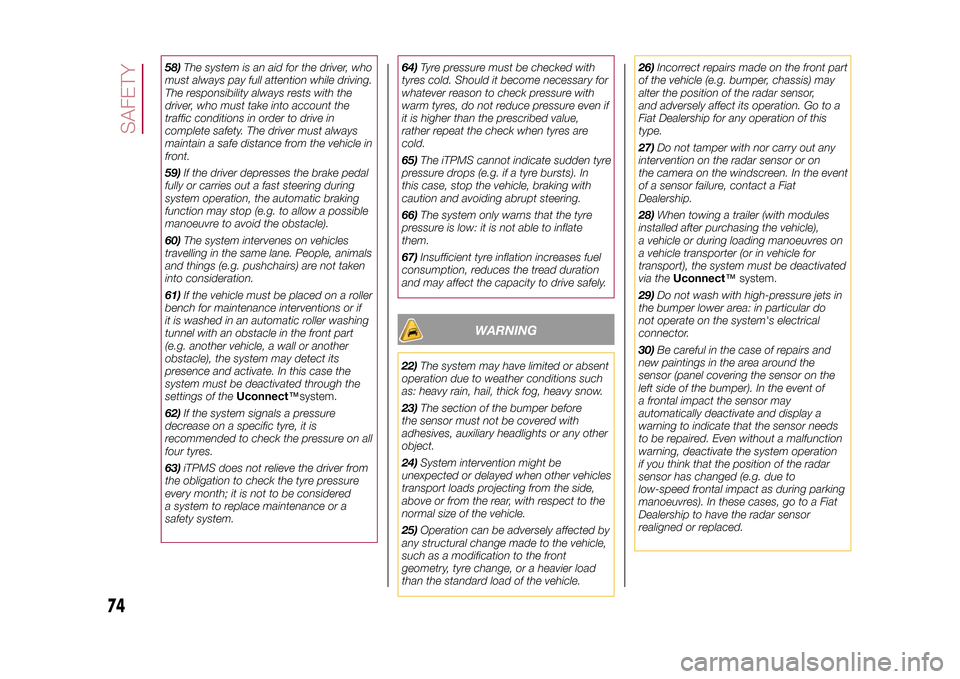
58)The system is an aid for the driver, who
must always pay full attention while driving.
The responsibility always rests with the
driver, who must take into account the
traffic conditions in order to drive in
complete safety. The driver must always
maintain a safe distance from the vehicle in
front.
59)If the driver depresses the brake pedal
fully or carries out a fast steering during
system operation, the automatic braking
function may stop (e.g. to allow a possible
manoeuvre to avoid the obstacle).
60)The system intervenes on vehicles
travelling in the same lane. People, animals
and things (e.g. pushchairs) are not taken
into consideration.
61)If the vehicle must be placed on a roller
bench for maintenance interventions or if
it is washed in an automatic roller washing
tunnel with an obstacle in the front part
(e.g. another vehicle, a wall or another
obstacle), the system may detect its
presence and activate. In this case the
system must be deactivated through the
settings of theUconnect™system.
62)If the system signals a pressure
decrease on a specific tyre, it is
recommended to check the pressure on all
four tyres.
63)iTPMS does not relieve the driver from
the obligation to check the tyre pressure
every month; it is not to be considered
a system to replace maintenance or a
safety system.64)Tyre pressure must be checked with
tyres cold. Should it become necessary for
whatever reason to check pressure with
warm tyres, do not reduce pressure even if
it is higher than the prescribed value,
rather repeat the check when tyres are
cold.
65)The iTPMS cannot indicate sudden tyre
pressure drops (e.g. if a tyre bursts). In
this case, stop the vehicle, braking with
caution and avoiding abrupt steering.
66)The system only warns that the tyre
pressure is low: it is not able to inflate
them.
67)Insufficient tyre inflation increases fuel
consumption, reduces the tread duration
and may affect the capacity to drive safely.
WARNING
22)The system may have limited or absent
operation due to weather conditions such
as: heavy rain, hail, thick fog, heavy snow.
23)The section of the bumper before
the sensor must not be covered with
adhesives, auxiliary headlights or any other
object.
24)System intervention might be
unexpected or delayed when other vehicles
transport loads projecting from the side,
above or from the rear, with respect to the
normal size of the vehicle.
25)Operation can be adversely affected by
any structural change made to the vehicle,
such as a modification to the front
geometry, tyre change, or a heavier load
than the standard load of the vehicle.26)Incorrect repairs made on the front part
of the vehicle (e.g. bumper, chassis) may
alter the position of the radar sensor,
and adversely affect its operation. Go to a
Fiat Dealership for any operation of this
type.
27)Do not tamper with nor carry out any
intervention on the radar sensor or on
the camera on the windscreen. In the event
of a sensor failure, contact a Fiat
Dealership.
28)When towing a trailer (with modules
installed after purchasing the vehicle),
a vehicle or during loading manoeuvres on
a vehicle transporter (or in vehicle for
transport), the system must be deactivated
via theUconnect™system.
29)Do not wash with high-pressure jets in
the bumper lower area: in particular do
not operate on the system's electrical
connector.
30)Be careful in the case of repairs and
new paintings in the area around the
sensor (panel covering the sensor on the
left side of the bumper). In the event of
a frontal impact the sensor may
automatically deactivate and display a
warning to indicate that the sensor needs
to be repaired. Even without a malfunction
warning, deactivate the system operation
if you think that the position of the radar
sensor has changed (e.g. due to
low-speed frontal impact as during parking
manoeuvres). In these cases, go to a Fiat
Dealership to have the radar sensor
realigned or replaced.
74
SAFETY
15-12-2014 8:23 Pagina 74
Page 122 of 240
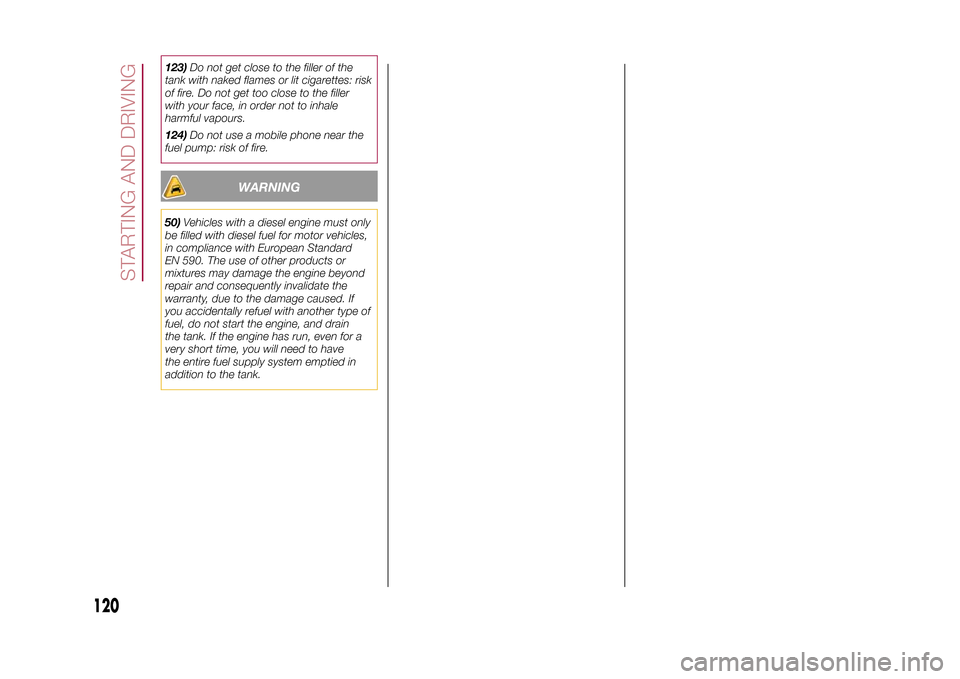
123)Do not get close to the filler of the
tank with naked flames or lit cigarettes: risk
of fire. Do not get too close to the filler
with your face, in order not to inhale
harmful vapours.
124)Do not use a mobile phone near the
fuel pump: risk of fire.
WARNING
50)Vehicles with a diesel engine must only
be filled with diesel fuel for motor vehicles,
in compliance with European Standard
EN 590. The use of other products or
mixtures may damage the engine beyond
repair and consequently invalidate the
warranty, due to the damage caused. If
you accidentally refuel with another type of
fuel, do not start the engine, and drain
the tank. If the engine has run, even for a
very short time, you will need to have
the entire fuel supply system emptied in
addition to the tank.
120
STARTING AND DRIVING
15-12-2014 8:23 Pagina 120
Page 176 of 240
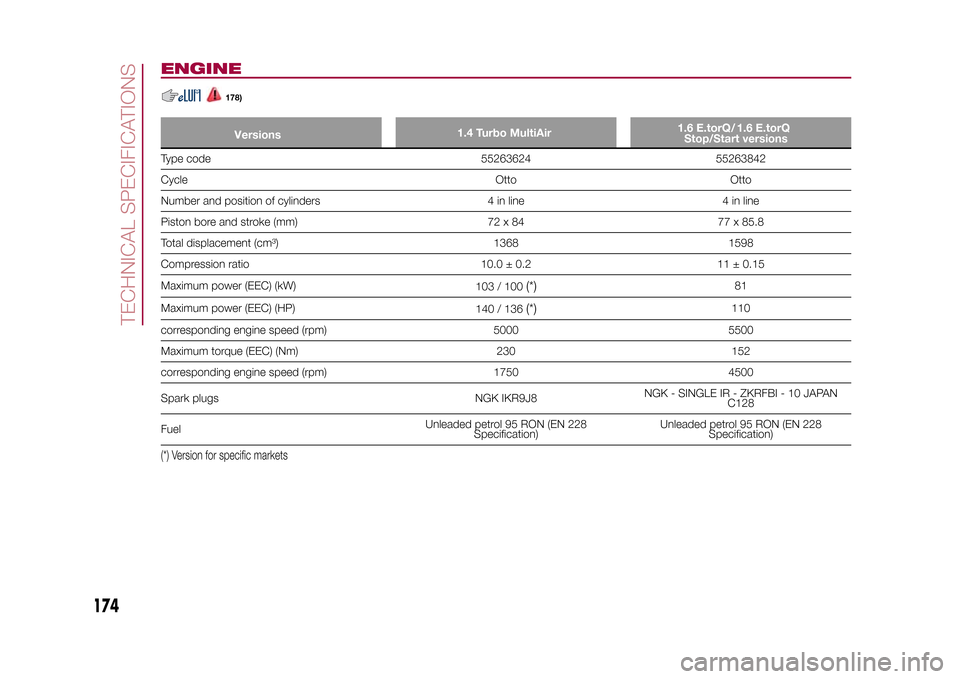
ENGINE
178)
1.4 Turbo MultiAir
Stop/Start versions
Type code 55263624 55263842
Cycle Otto Otto
Number and position of cylinders 4 in line 4 in line
Piston bore and stroke (mm) 72 x 84 77 x 85.8
Total displacement (cm³) 1368 1598
Compression ratio 10.0 ± 0.2 11 ± 0.15
Maximum power (EEC) (kW)
103 / 100
(*)
81
Maximum power (EEC) (HP)
140 / 136
(*)
110
corresponding engine speed (rpm) 5000 5500
Maximum torque (EEC) (Nm) 230 152
corresponding engine speed (rpm) 1750 4500
Spark plugs NGK IKR9J8NGK - SINGLE IR - ZKRFBI - 10 JAPAN
C128
FuelUnleaded petrol 95 RON (EN 228
Specification)Unleaded petrol 95 RON (EN 228
Specification)
(*) Version for specific markets
174
TECHNICAL SPECIFICATIONS
15-12-2014 8:23 Pagina 174
1.6 E.torQ/1.6 E.torQ
Versions
Page 177 of 240
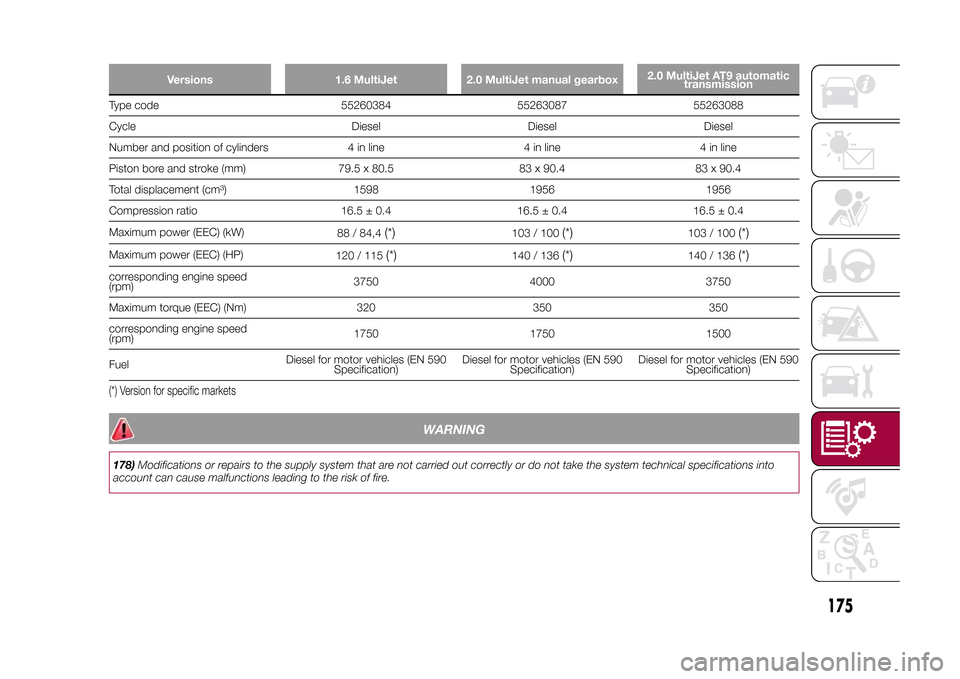
Versions 1.6 MultiJet 2.0 MultiJet manual gearbox2.0 MultiJet AT9 automatic
transmission
Type code 55260384 55263087 55263088
Cycle Diesel Diesel Diesel
Number and position of cylinders 4 in line 4 in line 4 in line
Piston bore and stroke (mm) 79.5 x 80.5 83 x 90.4 83 x 90.4
Total displacement (cm³) 1598 1956 1956
Compression ratio 16.5 ± 0.4 16.5 ± 0.4 16.5 ± 0.4
Maximum power (EEC) (kW)
88 / 84,4
(*)
103 / 100
(*)
103 / 100
(*)
Maximum power (EEC) (HP)
120 / 115
(*)
140 / 136
(*)
140 / 136
(*)
corresponding engine speed
(rpm)3750 4000 3750
Maximum torque (EEC) (Nm) 320 350 350
corresponding engine speed
(rpm)1750 1750 1500
FuelDiesel for motor vehicles (EN 590
Specification)Diesel for motor vehicles (EN 590
Specification)Diesel for motor vehicles (EN 590
Specification)(*) Version for specific markets
WARNING
178)Modifications or repairs to the supply system that are not carried out correctly or do not take the system technical specifications into
account can cause malfunctions leading to the risk of fire.
175
15-12-2014 8:23 Pagina 175
Page 188 of 240
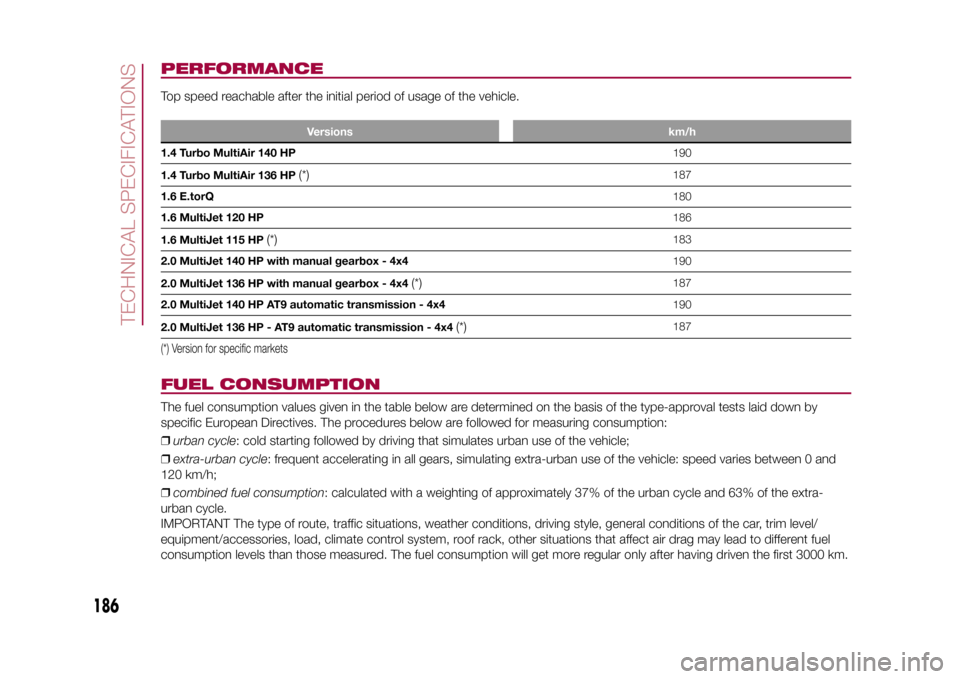
PERFORMANCETop speed reachable after the initial period of usage of the vehicle.
Versions km/h
1.4 Turbo MultiAir 140 HP190
1.4 Turbo MultiAir 136 HP
(*)
187
1.6 E.torQ180
1.6 MultiJet 120 HP186
1.6 MultiJet 115 HP
(*)
183
2.0 MultiJet 140 HP with manual gearbox - 4x4190
2.0 MultiJet 136 HP with manual gearbox - 4x4
(*)
187
2.0 MultiJet 140 HP AT9 automatic transmission - 4x4190
2.0 MultiJet 136 HP - AT9 automatic transmission - 4x4
(*)
187
(*) Version for specific marketsFUEL CONSUMPTIONThe fuel consumption values given in the table below are determined on the basis of the type-approval tests laid down by
specific European Directives. The procedures below are followed for measuring consumption:
❒urban cycle: cold starting followed by driving that simulates urban use of the vehicle;
❒extra-urban cycle: frequent accelerating in all gears, simulating extra-urban use of the vehicle: speed varies between 0 and
120 km/h;
❒combined fuel consumption: calculated with a weighting of approximately 37% of the urban cycle and 63% of the extra-
urban cycle.
IMPORTANT The type of route, traffic situations, weather conditions, driving style, general conditions of the car, trim level/
equipment/accessories, load, climate control system, roof rack, other situations that affect air drag may lead to different fuel
consumption levels than those measured. The fuel consumption will get more regular only after having driven the first 3000 km.
186
TECHNICAL SPECIFICATIONS
15-12-2014 8:23 Pagina 186